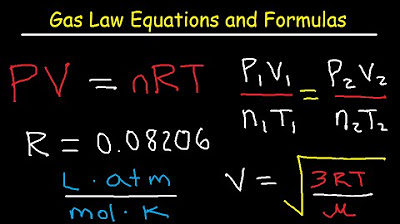Temperature: Crash Course Physics #20
TLDRThis Crash Course Physics video explains thermodynamics and temperature. It covers thermal expansion of solids like concrete in bridges, necessitating expansion joints to accommodate temperature changes. The ideal gas law relates pressure, volume, temperature and amount of gas. As temperature increases, solids expand and gases occupy more volume at constant pressure. The video applies ideal gas calculations to determine how temperature impacts air volume in a car, using universal gas constant R.
Takeaways
- 😀 Temperature measures kinetic energy and heat transfer flows from hotter to colder systems
- 👷♂️ Bridges have expansion joints to allow concrete to expand and contract with temperature changes
- 🔬 The change in an object's length due to temperature is proportional to its initial length and the temperature change
- 📏 Volume expansion works just like linear expansion but happens in 3 dimensions
- 🚘 Gases also expand with increased temperature based on Boyle's, Charles's and Gay-Lussac's laws
- 🧪 These laws combine into the ideal gas law relating pressure, volume, temperature and number of gas molecules
- 🌡️ Applying the ideal gas law shows there are fewer moles of air in a car on a hot afternoon than a cold morning
- ⏱ Changes in temperature cause both expansion and contraction in solids and gases over time
- 🏗 Engineering structures like bridges need to account for thermal expansion to avoid failures
- 🌋 Thermodynamics studies how heat & temperature impact and change the states of matter
Q & A
What are expansion joints and why are they necessary in bridges?
-Expansion joints are cracks in concrete bridges that contain metal grating. They allow the concrete room to expand and contract with changes in temperature without putting too much stress on the bridge.
How does temperature affect the dimensions of a solid object?
-An increase in temperature generally makes a solid expand, while a decrease makes it contract. This can happen in terms of length (linear expansion) or volume.
What is the equation relating change in length to temperature change?
-The change in length is equal to the coefficient of linear expansion multiplied by the original length and the change in temperature.
What are the basic gas laws described?
-Boyle's law relates pressure and volume, Charles's law relates volume and temperature, and Gay-Lussac's law relates pressure and temperature.
How are pressure, volume, temperature and amount of gas related?
-The ideal gas law states: Pressure x Volume = Number of Moles x Gas Constant x Temperature. This combines the other gas laws into one equation.
What assumptions are made about an ideal gas?
-An ideal gas is made of molecules that move randomly and exert no forces on each other except during collisions. The volume of the molecules is negligible compared to the container volume.
How can the ideal gas law be applied to a real-life example?
-It can calculate, for example, how many fewer moles of air are in a car on a hot afternoon compared to a cold morning, based on the temperature change, while pressure and volume stay constant.
What causes thermal expansion in solids?
-Thermal expansion is caused by an increase in kinetic energy and motion of atoms and molecules as temperature rises. This makes the molecules take up more space.
What is temperature a measure of?
-Temperature measures the average kinetic energy or energy of motion in a system. Higher temperature means greater molecular motion.
How does heat transfer relate to temperature?
-Heat flows spontaneously from higher temperature to lower temperature systems. If no heat transfer occurs, the systems are in thermal equilibrium.
Outlines
🌉 Why Bridges Need Expansion Joints
This segment of Crash Course Physics, sponsored by Audible, delves into the structural integrity of bridges, emphasizing the importance of expansion joints. These joints, marked by metal grating within cracks in the concrete, are crucial for accommodating the thermal expansion and contraction caused by temperature variations. The physics behind this phenomenon is explained through the principles of thermodynamics and temperature's impact on kinetic energy. The episode further explores how temperature changes lead to thermal expansion, using the coefficient of linear expansion to illustrate how materials expand or contract. This concept is vital for preventing stress and potential failure in bridges and is extended to volume expansion in solids and gases, emphasizing the fundamental role of temperature in material properties and gas behaviors.
🌡️ Understanding the Ideal Gas Law
The second part of the episode focuses on how temperature changes affect gases, leading into a detailed explanation of the ideal gas law (PV = nRT). This law integrates Boyle's Law, Charles's Law, and Gay-Lussac's Law to describe the relationship between pressure, volume, temperature, and the amount of gas. By applying these concepts to a practical scenario—calculating the change in moles of air inside a car from morning to afternoon due to temperature fluctuations—the segment illustrates the direct impact of thermal physics in everyday life. Furthermore, it touches on the educational resources available through Audible, like Stephen Hawking's 'A Brief History of Time', and promotes Crash Course Physics' association with PBS Digital Studios, highlighting the collaborative efforts to make complex scientific principles accessible and engaging.
Mindmap
Keywords
💡Thermal expansion
💡Stress and strain
💡Heat transfer
💡Thermal equilibrium
💡Kinetic energy
💡Ideal gas law
💡Boyle's law
💡Charles's law
💡Gay-Lussac's law
💡Coefficients of expansion
Highlights
First significant research finding
Introduction of new theoretical model
Proposed innovative analysis method
Key conclusions and practical applications
Transcripts
Browse More Related Video
5.0 / 5 (0 votes)
Thanks for rating:





